Our official English website, www.x-mol.net, welcomes your
feedback! (Note: you will need to create a separate account there.)
Mesoarchean gabbro-anorthosite complex from Singhbhum Craton, India
Lithos ( IF 2.9 ) Pub Date : 2020-08-01 , DOI: 10.1016/j.lithos.2020.105541 C. Manikyamba , Arijit Pahari , M. Santosh , Jyotisankar Ray , C.S. Sindhuja , K.S.V. Subramanyam , Mutum Rajanikanta Singh
Lithos ( IF 2.9 ) Pub Date : 2020-08-01 , DOI: 10.1016/j.lithos.2020.105541 C. Manikyamba , Arijit Pahari , M. Santosh , Jyotisankar Ray , C.S. Sindhuja , K.S.V. Subramanyam , Mutum Rajanikanta Singh

|
Abstract The Singhbhum Craton in Peninsular India preserves some of the oldest continental crust on the globe with Hadean and Paleoarchean zircon record. Here we investigate a gabbro-anorthosite complex from the eastern margin of the craton exposed at Besoi, Kuliana, Sarat and Jashipura areas. These rocks display moderate SiO2 (47.94–53.77 wt%), TiO2 (0.42–2.17 wt%), Al2O3 (8.97–14.96 wt%) MgO (6.14–10.30 wt%) and CaO (10.73–15.07 wt.) at low to moderate Cr (20–862 ppm), Ni (32–636 ppm) and V (81–666 ppm) and are classified as noritic gabbros and gabbros. Their rare earth and trace element patterns exhibit mild to moderate fractionation with coherent patterns (La/Yb = 1.71–14.59), negative to positive Eu anomalies (Eu/Eu* = 0.62–1.44) negative Nb, Ti and sparingly negative to positive Zr Hf anomalies. The U Pb analysis of zircon grains from the Jashipura gabbros yield upper intercept ages of 3047 to 3099 Ma and the 3047 Ma age is considered to mark the timing of emplacement. Our geochemical data suggest that these rocks were generated through fractional crystallization of magma in a magma chamber at a transitional depth of the spinel-garnet regime with subsequent crustal contamination at an active continental margin supporting a continental arc setting. The gabbro-anorthosite suites in this region are synchronous with the adjacent granites and we propose that the mafic magma provided the heat for crustal melting that generated the granitoids. This magmatic event coincides with the ca. 3.1 Ga widespread crustal growth event in the Singhbhum Craton.
中文翻译:

印度辛格布姆克拉通中太古代辉长岩-斜长岩复合体
摘要 印度半岛的辛格布姆克拉通保存了地球上一些最古老的大陆地壳,其中有冥古宙和古太古代锆石记录。在这里,我们调查了在 Besoi、Kuliana、Sarat 和 Jashipura 地区出露的克拉通东缘的辉长岩-斜长岩复合体。这些岩石显示中等 SiO2 (47.94–53.77 wt%)、TiO2 (0.42–2.17 wt%)、Al2O3 (8.97–14.96 wt%)、MgO (6.14–10.30 wt%) 和 CaO (10.73–15.07 wt%) 至低至中等 Cr (20-862 ppm)、Ni (32-636 ppm) 和 V (81-666 ppm),被归类为诺瑞克辉长岩和辉长岩。它们的稀土和微量元素模式表现出轻度至中度分馏,具有相干模式(La/Yb = 1.71–14.59),负至正 Eu 异常(Eu/Eu* = 0.62–1.44)负 Nb、Ti 和极少负正 Zr高频异常。Jashipura辉长岩锆石颗粒的U Pb分析得出3047至3099 Ma的上截距年龄,3047 Ma年龄被认为是侵位时间的标志。我们的地球化学数据表明,这些岩石是通过在尖晶石-石榴石体系过渡深度的岩浆房中的岩浆分步结晶形成的,随后在支持大陆弧环境的活动大陆边缘受到地壳污染。该地区辉长岩-斜长岩组与相邻的花岗岩同步,我们认为基性岩浆为产生花岗岩的地壳熔融提供了热量。这个岩浆事件与大约一致。3.1 Singhbhum 克拉通中 Ga 广泛的地壳生长事件。
更新日期:2020-08-01
中文翻译:

印度辛格布姆克拉通中太古代辉长岩-斜长岩复合体
摘要 印度半岛的辛格布姆克拉通保存了地球上一些最古老的大陆地壳,其中有冥古宙和古太古代锆石记录。在这里,我们调查了在 Besoi、Kuliana、Sarat 和 Jashipura 地区出露的克拉通东缘的辉长岩-斜长岩复合体。这些岩石显示中等 SiO2 (47.94–53.77 wt%)、TiO2 (0.42–2.17 wt%)、Al2O3 (8.97–14.96 wt%)、MgO (6.14–10.30 wt%) 和 CaO (10.73–15.07 wt%) 至低至中等 Cr (20-862 ppm)、Ni (32-636 ppm) 和 V (81-666 ppm),被归类为诺瑞克辉长岩和辉长岩。它们的稀土和微量元素模式表现出轻度至中度分馏,具有相干模式(La/Yb = 1.71–14.59),负至正 Eu 异常(Eu/Eu* = 0.62–1.44)负 Nb、Ti 和极少负正 Zr高频异常。Jashipura辉长岩锆石颗粒的U Pb分析得出3047至3099 Ma的上截距年龄,3047 Ma年龄被认为是侵位时间的标志。我们的地球化学数据表明,这些岩石是通过在尖晶石-石榴石体系过渡深度的岩浆房中的岩浆分步结晶形成的,随后在支持大陆弧环境的活动大陆边缘受到地壳污染。该地区辉长岩-斜长岩组与相邻的花岗岩同步,我们认为基性岩浆为产生花岗岩的地壳熔融提供了热量。这个岩浆事件与大约一致。3.1 Singhbhum 克拉通中 Ga 广泛的地壳生长事件。











































 京公网安备 11010802027423号
京公网安备 11010802027423号